This was published 6 years ago
Tzfat, Israel: A mystical, spiritual experience
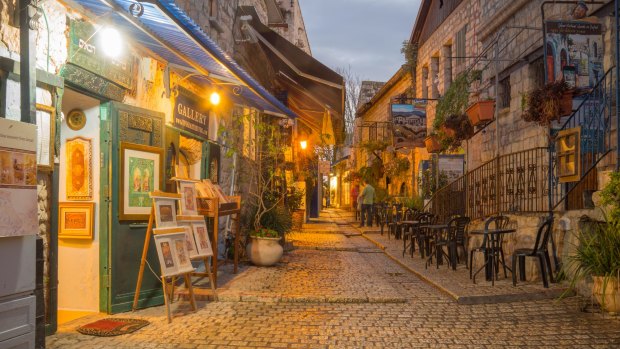
Twilight in the town centre of Tzfat, Israel.Credit: Shutterstock
I arrive in Tzfat on a Saturday, the very day my guidebook had warned me not to. Business in this northern Israeli town, a centre of Kabbalah Jewish mysticism since the 16th century, completely shuts down on Shabbat, the Jewish day of rest. I wouldn't be able to get a meal, peruse the town's shops and art galleries, even get into my hotel, the guidebook had warned.
And yet, here my husband and I are. Guidebook rebels, wandering the eerily quiet streets of Israel's loftiest mountaintop town on a Saturday afternoon. In the town's Artists' Quarter we pass dozens of restaurants, boutiques and galleries, their stained-glass windows, and doors painted the deep cobalt of Judain divinity, all resolutely closed.
Since devout Jews who observe the Shabbat aren't allowed to do any chores including driving, shopping, cooking or cleaning on Saturdays, local families are all out walking the car-free streets. The men in their heavy black coats, round rabbit fur hats and tight, shiny ringlets at their ears; the women in turbans, modest long-sleeved blouses and ankle-skimming skirts, many with four or more children in tow. It is quiet, the air is still. And as the sun starts to sink, the narrow, biscuit-coloured stone alleyways and quiet cobbled courtyards glow gold. Despite being firm in our atheism, my husband and I agree that this place seems touched by a special energy that we can only describe as spiritual.
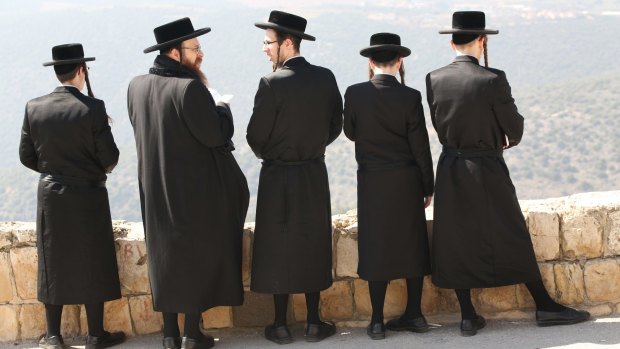
Orthodox Jews pray at the ancient old cemetery.Credit: Shutterstock
When our stomachs start grumbling, we jump in our rental car and drive 20 minutes to the neighbouring town of Rosh Pinna for supper. A drive locals deem arduous, but that us Aussies, coming from a country roughly 370 times the size of Israel, deem barely a drive at all. We arrive to find quaint cobbled streets lined with sprawling country houses, many functioning as charming B&Bs, and settle in for dinner of fresh fish and salad in the courtyard of one called Pina Barosh.
By the time we've finished eating Shabbat is officially over, and we're finally able to check in at Tzfat's Artists Quarter Guesthouse. We're greeted by our host Joy, a Californian expat whose scarf-wrapped hair and transcendent smile immediately give her away as one of the town's Kabbalistic residents. Joy shows us into our room, a renovated 300-year-old space with a soaring domed ceiling, blue stained glass windows and rough sandstone walls. It feels as if we're staying in a monastery, and we sleep as peacefully as monks.
The following morning, after filling up on Joy's spicy shakshuka eggs, crunchy Israeli salad and creamy labneh, we head out to explore the Golan Heights region in which Tzfat is set. By the time we've driven 50 minutes along the highway to the Yehudiya Forest, the largest nature reserve in the Golan, it's already 35 degrees. The heat makes our hike through the parched, rocky terrain, carpeted with dry yellow grasses, stocky olive trees and the remainder of spring's purple globe thistle flowers, about as comfortable as playing squash in a leather catsuit. But just as we're about ready to give up, the earth splits and drops into a foliage-filled canyon, a deep, waterfall-fed pool winking at us from its base. Skittering down to the banks of the 25-metre Hexagon Pool, we strip down to our togs and throw our sweat-soaked bodies into the bracing water. Surrounded by hundreds of hexagonal basalt columns formed from lava flows millions of years ago, we paddle until our bodies have returned to their normal temperatures, then lay out under oleander trees heavy with pink flowers.
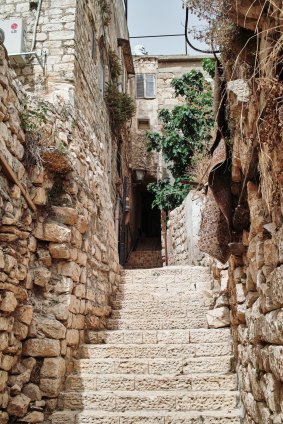
The twisting, ancient paths of Tzfat.Credit: Shutterstock
Back at the Artists' Quarter Guesthouse the sun is setting, and we make our way up to the rooftop terrace just as an exceptionally golden light starts raking through the mountains. As we coo over the light, Joy's husband Evan appears, his smile equally as otherworldly as his wife's.
"There's a reason why the light in Tzfat is so special," he says mysteriously, nodding his head towards the mountains. "The famous second century Rabbi Shimon Bar Yochai, who wrote the Zohar [the chief work of the Kabbalah] was buried in that mountain over there. So they say it has geula, or redemptive energy and light, coming down to it from heaven."
Whether or not we believe in the geula, it has played a part in drawing spiritual seekers like Joy and Evan to Tzfat since the 16th century. Back then, Sephardic rabbis, sages and poets escaping the Spanish inquisition settled here, making it a destination for Jews wishing to get a blessing from the rabbis, and giving the city a unique, bohemian character. This atmosphere continues to draw a mixture of devout and creative souls to Tzfat today, making it a town ideal for pottering, for ambling, for idling – and for poking around its many galleries and creative boutiques.
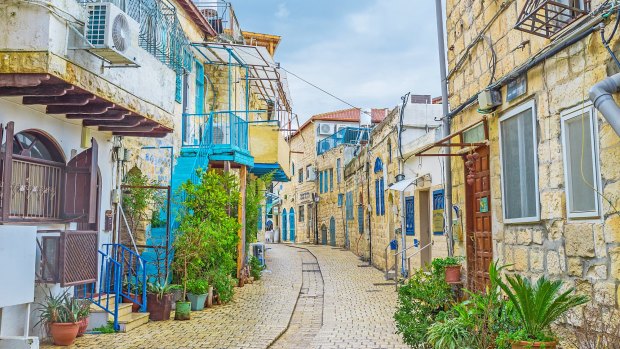
The streets of Safed, Israel, are hilly, narrow and twisted.Credit: Shutterstock
We spend the following morning doing just that. At the studio of Russian artist Masha Orlovitch we peruse watercolours, oils and encaustics, with subjects ranging from floating jellyfish, to Tzfat landscapes. Under the soaring arches and domed ceilings of the old Market Mosque we find the General Exhibition, showing works by members of Tzfat's Artists' Colony. And in Yakov Hadad's gallery we discover some of Israel's most well-known artists, including abstractionist Moshe Castel. Afterwards, we explore boutiques hawking everything from ceramics, to handmade jewellery, to candles – and find ourselves in conversation with another Californian expat hippie who, within minutes, has invited us skinny dipping in the nearby Sea of Galillee.
Alas, we're a little shy about nude swimming with strangers – and besides, we have more road tripping to attend to. Today we drive further north where, in among orchards, cattle ranches and vineyards, we pass abandoned Syrian bunkers and tanks, reminders of the tumultuous history of the Golan Heights. Since Biblical times it has been fought over, being settled by the ancient Israelites, the Itureans, Arabs, the Ottoman Empire, the French, Syria, and most recently Israel, when it was recaptured during the 1967 Six Day War. In the bitter 1973 Yom Kippur War, Syrian forces briefly took over before being pushed back. These days, as travel advisory sites will tell you, the Golan remains one of Israel's most unstable regions.
We spend a couple of eerily quiet hours hiking through the waterfall-dotted Iyyon nature reserve, from where we can see the wire fences of the Lebanese border just 100 metres away. Afterwards, we drive up to Mount Bental, a dormant volcano where one of the largest tank battles in history took place during the Yom Kippur War. From the top, we gaze out over the Valley of Tears to the Israeli-Syrian disengagement zone, and beyond to Damascus just 60 kilometres away. We explore old army bunkers and trenches, and fall into conversation with UN peacekeepers who tell us they've been stationed on the mountain to monitor escalating tensions on the frontier.
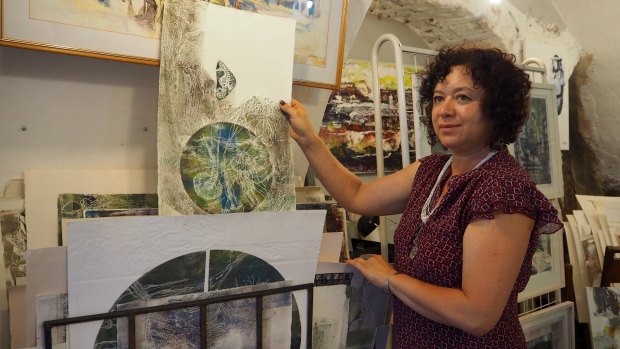
Artist Masha Orlovitch.Credit: Nina Karnikowski
It's confronting, being this close to one of the world's most volatile conflict zones, and in stark contrast to the peacefulness we've been experiencing in Tzfat. But later, as we burrow into tasty eggplant salad and tahini at Gan Eden mountaintop restaurant, we agree that today was important, and strangely energising. Being reminded of our own mortality has reminded us to seize the day. We feast. We lift our glasses. We think, perhaps, that we should have gone skinny dipping after all.
TRIP NOTES
MORE
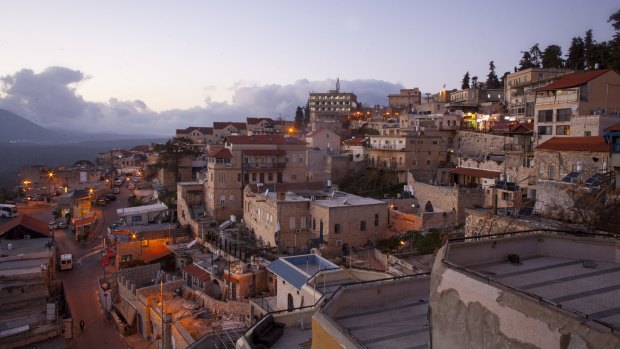
The nearby town of Safed in northern Israel.Credit: Shutterstock
FLY
Cathay Pacific Airways flies to Tel Aviv via Hong Kong from every capital city for about $2300 return. See cathaypacific.com
STAY
The Way Inn is another great Safed guesthouse, offering seven character-filled studios and suites housed in ancient interconnected stone buildings, interspersed with numerous patios with mountain views. Don't miss the Turkish hammam and spa. From $250 a night; see thewayinn.co.il
Nina Karnikowski travelled with assistance from the Australian Embassy of Israel and Cathay Pacific Airways.
FIVE OTHER THINGS TO SEE AND DO AROUND THE GOLAN HEIGHTS
ROSH HANIKRA GROTTOES
On the Lebanese border on Israel's northwestern tip, you'll find this series of natural sea caves and tunnels. You can't swim in them, but they are beautiful to admire.
SEA OF GALILEE
The banks of Israel's biggest freshwater lake, where Jesus supposedly walked on water, are dotted with holy sites and beaches. Pick one (Hukuk is a good option) for an afternoon of swimming and lazing beneath waving palms.
BANIAS NATURE RESERVE
One of the most popular nature spots in the Golan, Banias is filled with waterfalls, streams, and lush paths.
NIMROD FORTRESS
Israel's largest and arguably most impressive Crusader fortress, Nimrod's well-preserved ruins also have great views of the Golan.
TISHBI WINERY
Yes, Tishbi makes some of the best wine in Israel, but it's also home to a bespoke bakery, two restaurants, a chocolate and wine jelly tasting room and more. See tishbi.com
Sign up for the Traveller Deals newsletter
Get exclusive travel deals delivered straight to your inbox. Sign up now.